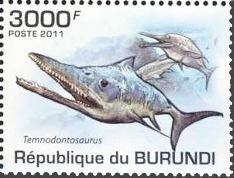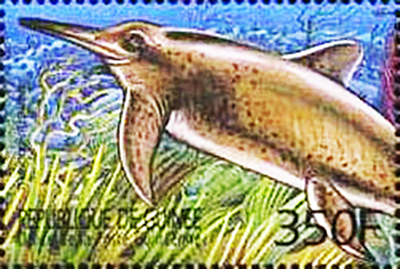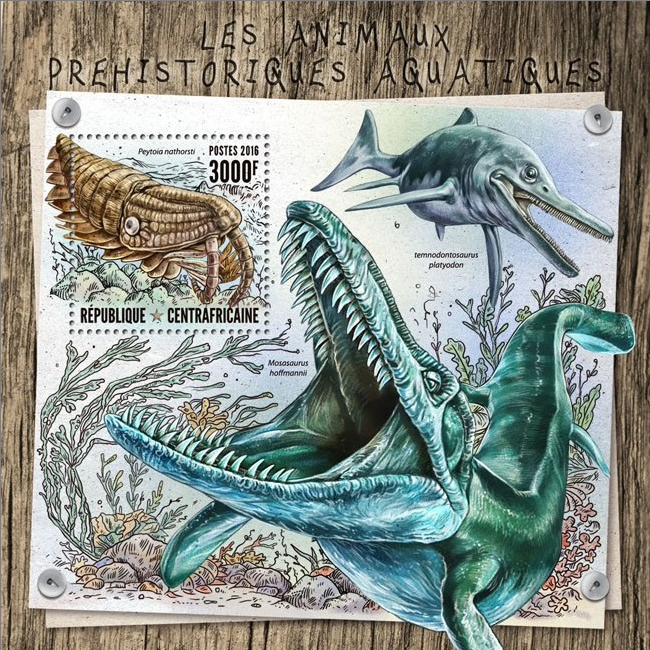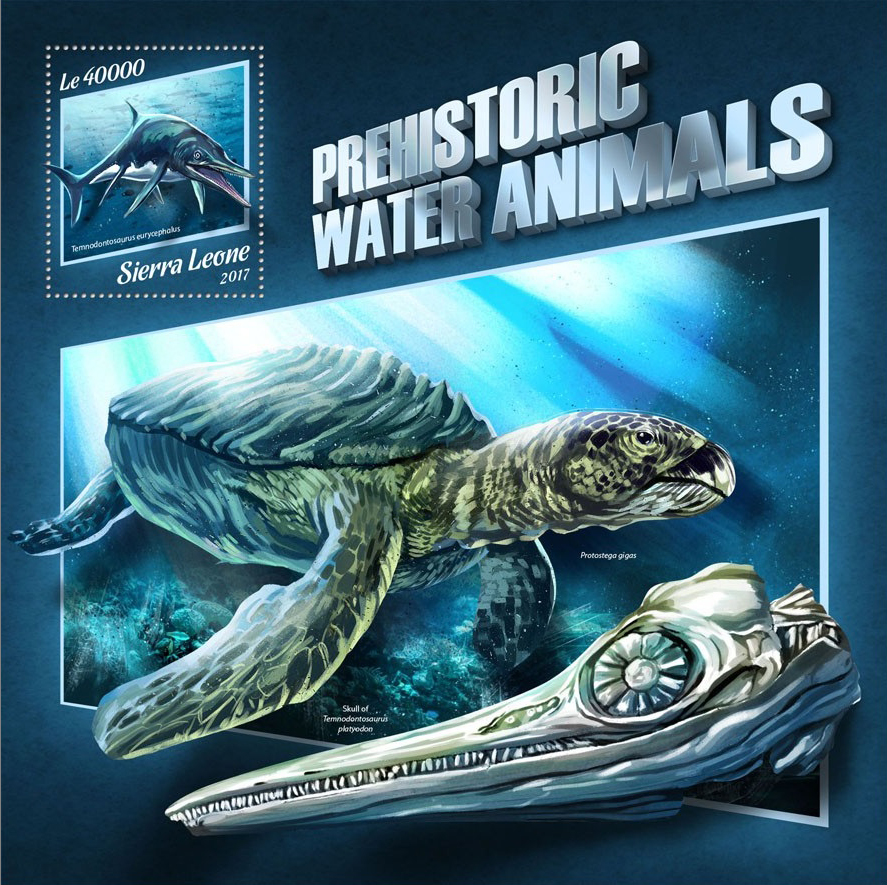Temnodontosaurus platyodon Lydekker, 1889

(Da: it.wikipedia.org)
Phylum: Chordata Haeckel, 1874
Subphylum: Vertebrata Cuvier, 1812
Classe: Reptilia Laurenti, 1768
Ordine: Ichthyosauria Blainville, 1835
Famiglia: Temnodontosauridae McGowan, 1974
Genere: Temnodontosaurus Lydekker, 1889
Descrizione
Aveva un muso lungo, un corpo a barile e una potente coda a due lobi. Gli occhi erano più grandi di qualunque altro animale, estinto o vivente. Il loro diametro era di circa 26 centimetri ed erano circondati da un anello di sottili placche ossee sovrapposte, che li proteggevano durante le immersioni. È possibile che occhi tanto grandi fossero un adattamento per la caccia notturna. È conosciuto talvolta come Leptopterygius. Il corpo aerodinamico e le lunghe mandibole erano fatti per catturare prede veloci. La sua dieta era a base di pesce, ma mangiava anche ammoniti, calamari e altri grandi molluschi cefalopodi: ne sono stati trovati i resti fossili all'interno degli scheletri di questi rettili. Probabilmente le femmine si prendevano cura dei piccoli e li addestravano alla caccia.
Diffusione
Il temnodontosauro era un grosso ittiosauro del Giurassico, lungo 9 metri ritrovato in Europa (Regno Unito, Germania).
Bibliografia
–Michael W. Maisch; Andreas T. Matzke (2000). "The Ichthyosauria". Stuttgarter Beiträge zur Naturkunde, Serie B. 298: 1-159.
–Christopher McGowan; Ryosuke Motani (2003). Hans-Dieter Sues (ed.). Handbook of Paleoherpetology Part 8: Ichthyopterygia. Munich: Verlag Dr. Friedrich Pfeil.
–Oliver Perry Hay (1902). Bibliography and catalogue of the fossil Vertebrata of North America. Bulletin of the United States Geological Survey. Washington: Government Printing Office. p. 462.
–Christopher McGowan (1974). "A revision of the Longipinnate Ichthyosaurs of the Lower Jurassic of England, with descriptions of two new species (Reptilia: Ichthyosauria)". Life Sciences Contributions, Royal Ontario Museum. 97: 1-37.
–Chris McGowan (1995). "Temnodontosaurus risor is a juvenile of T. platyodon (Reptilia: Ichthyosauria)". Journal of Vertebrate Paleontology. 14 (4): 472-479.
–Emily J. Swaby; Dean R. Lomax (2021). "A revision of Temnodontosaurus crassimanus (Reptilia: Ichthyosauria) from the Lower Jurassic (Toarcian) of Whitby, Yorkshire, UK". Historical Biology. 31 (11): 2715-2731.
–Antoine Laboury; Rebecca F. Bennion; Ben Thuy; Robert Weis; Valentin Fischer (2022). "Anatomy and phylogenetic relationships of Temnodontosaurus zetlandicus (Reptilia: Ichthyosauria)". Zoological Journal of the Linnean Society. 195 (1): 172-194.
–Michael W. Maisch; Axel Hungerbühler (1997). "Revision of Temnodontosaurus nuertingensis (v. Huene, 1931), a large ichthyosaur from the Lower Pliensbachian (Lower Jurassic) of Nürtingen, South Western Germany". Stuttgarter Beiträge zur Naturkunde Serie B (Geologie und Paläontologie). 248: 1-11.
–Christopher McGowan (1992). "The Sea Dragons". Dinosaurs, spitfires, and sea dragons. Cambridge: Harvard University Press. p. 246.
–Hugh Torrens (1995). "Mary Anning (1799–1847) of Lyme; 'the greatest fossilist the world ever knew'". The British Journal for the History of Science. 25 (3): 257-284.
–Deborah Cadbury (2000). "Epilogue". The Dinosaur Hunters : A True Story of Scientific Rivalry and the Discovery of the Prehistoric World. London: Fourth Estate. pp. 323-324.
–Everard Home (1814). "Some account of the fossil remains of an animal more nearly allied to fishes than any of the other classes of animals". Philosophical Transactions of the Royal Society of London. 104: 571-577.
–Everard Home (1819). "Reasons for giving the name Proteo-Saurus to the fossil skeleton which has been described". Philosophical Transactions of the Royal Society of London. 109: 212-216.
–Henry T. De la Beche; William D. Conybeare (1821). "Notice of the discovery of a new Fossil Animal, forming a link between the Ichthyosaurus and Crocodile, together with general remarks on the Osteology of the Ichthyosaurus". Transactions of the Geological Society of London. 2. 5: 559-594.
–Henry T. De la Beche (1822). "Remarks on the Geology of the South Coast of England, from Bridport Harbour, Dorset, to Babbacombe Bay, Devon". Transactions of the Geological Society of London. 2. 1 (1): 40-47.
–William D. Conybeare (1822). "Additional Notices on the Fossil Genera Ichthyosaurus and Plesiosaurus". Transactions of the Geological Society of London. 2. 1 (1): 103-123.
–Henry G. Liddell; Robert Scott (1980) [1871]. A Greek-English Lexicon (abridged ed.). Oxford: Oxford University Press.
–Richard Owen (1881). A monograph of the fossil Reptilia of the Liassic formations, Part III, Ichthyopterygia. London: Printed for the Palæontographical Society. pp. 83-134.
–Henry A. Nicholson; Richard Lydekker (1889). "Palaeozoology; Vertebrata". A manual of palaeontology for the use of students with a general introduction on the principles of palaeontology. Vol. 2. Edinburgh and London: William Blackwood and Sons. pp. 889-1464.
–Ryosuke Motani (2000). "Rulers of the Jurassic Seas". Scientific American. 283 (6): 52-59.
–Ivan R. Schwab (2002). "My, what big eyes you have . . ". The British Journal of Ophthalmology. 86 (2): 130.
–Christopher McGowan (1972). "The Distinction between Latipinnate and Longipinnate Ichthyosaurs". Life Science Contributions, Royal Ontario Museum. 20: 1-12.
–Christopher McGowan (1972). "Evolutionary Trends in Longipinnate Ichthyosaurs, with Particular Reference to the Skull and Fore Fin". Life Science Contributions, Royal Ontario Museum. 83: 1-38.
–Arthur Smith Woodward; Charles Davies Sherborn (1890). A catalogue of British fossil Vertebrata. London: Dulau & Co. p. 240.
–Nigel R. Larkin; Dean R. Lomax; Mark Evans; Emma Nicholls; Steven Dey; Ian Boomer; Philip Copestake; Paul Bown; James B. Riding; Darren Withers; Joseph Davis (2023). "Excavating the 'Rutland Sea Dragon': The largest ichthyosaur skeleton ever found in the UK (Whitby Mudstone Formation, Toarcian, Lower Jurassic)". Proceedings of the Geologists' Association. 134 (5-6): 627-640.

|
Data: 01/12/2011
Emissione: Animali preistorici Stato: Burundi |
|---|

|
Data: 12/08/1999
Emissione: Fauna preistorica Stato: Guinea |
|---|

|
Data: 21/11/2016
Emissione: Animali preistorici acquatici Stato: Central African Republic Nota: Presente nel foglietto |
|---|

|
Data: 29/09/2017
Emissione: Animali preistorici acquatici Stato: Sierra Leone |
|---|